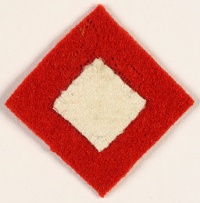The 43rd Royal Tank Regiment was an armoured regiment of the British Army's Royal Armoured Corps that tested and demonstrated specialised Armoured Fighting Vehicles during World War II.

The 21st Army Tank Brigade was an armoured brigade formation of the British Army active during the Second World War. The brigade served with the British First Army and the British Eighth Army during the fighting in Tunisia and Italy.

The 6th Armoured Division was an armoured division of the British Army, created in September 1940 during the Second World War and re-formed in May 1951 in the UK.

The 23rd Armoured Brigade, originally formed as the 23rd Army Tank Brigade, was an armoured brigade of the British Army that saw service during the Second World War. The brigade was a 2nd Line Territorial Army (TA) formation. It was reorganised and renamed the 23rd Armoured Brigade, when it was assigned to the 8th Armoured Division, although it never operated under command of the division.
The 10th Armoured Brigade was a short-lived armoured brigade of the British Army in the Second World War. It had been converted in November 1941 from infantry battalions, but had never seen action and was disbanded in late 1943.

The 10th Armoured Division was an armoured formation of division-size of the British Army, raised during the Second World War and was active from 1941–1944 and after the war from 1956–1957. It was formed from the 1st Cavalry Division, a 1st Line Yeomanry unit of the Territorial Army (TA) which had previously been serving in Palestine. The division was converted from cavalry to armour and redesignated from 1 August 1941.

The 42nd Armoured Division was an armoured division of the British Army raised during the Second World War.
The 50th Indian Tank Brigade was an armoured brigade formation of the Indian Army during World War II. It was formed for service in the Burma Campaign of World War II from units of the British Army and the British Indian Army. The brigade's formation emblem was a white upraised fist and forearm on a black disc.
During the Second World War the British Army deployed armoured divisions and independent armoured and tank brigades.

The 144th Regiment Royal Armoured Corps was an armoured regiment of the British Army. Originally raised during World War II as a battalion of the East Lancashire Regiment it was later transferred to the Royal Armoured Corps. It fought in the campaign in North-West Europe, from June 1944 to May 1945.
The 33rd Army Tank Brigade was an armoured brigade formation of the British Army raised during the Second World War.

The 148th Regiment Royal Armoured Corps was an armoured regiment of the British Army's Royal Armoured Corps during World War II. It fought in the invasion of Normandy in 1944.
The 107th Regiment Royal Armoured Corps (King's Own) (107 RAC) was a tank regiment of the Royal Armoured Corps, raised by the British Army during the Second World War. The regiment served with distinction in North-west Europe from July 1944 to May 1945.

The 145th Regiment Royal Armoured Corps was an armoured regiment of the British Army's Royal Armoured Corps that served in North Africa, Tunisia and Italy during World War II.
149th Regiment Royal Armoured Corps was an armoured regiment of the British Army's Royal Armoured Corps that served in the Burma Campaign during World War II.
109th Regiment Royal Armoured Corps (The Lancashire Fusiliers) (109 RAC) was an armoured regiment of the British Army's Royal Armoured Corps during World War II.
The 111th Regiment Royal Armoured Corps (Manchester Regiment) (111 RAC) was an armoured regiment of the British Army, raised by the Royal Armoured Corps during the Second World War.








